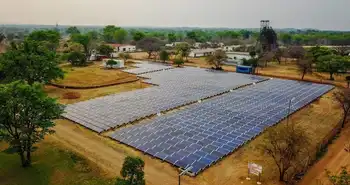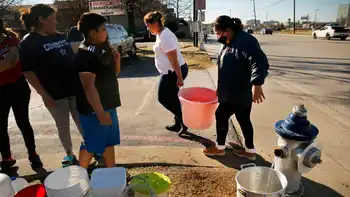TECO finishes decade-long environmental program
TAMPA BAY, FLORIDA - Tampa Electric announced that the installation of state-of-the-art Selective Catalytic Reduction SCR equipment at the companyÂ’s Big Bend Power Station Unit 1 is complete.
Big Bend Power StationÂ’s Unit 1 is the fourth and last of four units to receive the new equipment, which is designed to further reduce nitrogen oxide NOx emissions at the plant. The Unit 4 SCR was completed in June 2007, Unit 3 was completed in May 2008 and Unit 2 was completed in May 2009.
“The completion of the SCR project is the final component of our 10-year environmental improvement plan that defines Tampa Electric as an industry leader in our commitment to sustainability,” said President Gordon Gillette. “I’m proud of our project team’s work to put this technology to use to benefit our customers and the environment, on time and on budget.”
The massive project was particularly complex in that it had to be installed while Big BendÂ’s other units continued to operate. Gillette said he is particularly proud of the SCR project teamÂ’s outstanding safety record: zero lost-time accidents in more than 3 million man-hours worked. The project created more than 1,500 jobs during the six years of planning, engineering and construction.
The SCR project was part of a 10-year, $1.2 billion program undertaken by Tampa Electric as the centerpiece of the companyÂ’s 1999 agreement with the Environmental Protection Agency EPA and the Florida Department of Environmental Protection FDEP to dramatically reduce overall emissions from Tampa ElectricÂ’s power plants.
As part of the environmental improvement program, the company also repowered the nearly 50-year-old coal-burning Gannon Power Station to natural gas in 2003 and 2004, creating the H.L. Culbreath Bayside Power Station.
In December 1999, when Tampa Electric initially announced its 10-Year environmental plan, company president John Ramil said, “At Tampa Electric, we’re always evaluating the most cost-effective, environmentally responsive technologies available to expand our power generation capabilities. Through implementation of this different technology, we will be able to significantly reduce environmental emissions while providing clean, reliable and affordable energy to our customers.”
Today Ramil, TECO Energy’s president and chief operating officer said, “I am pleased that we successfully fulfilled our 10-year commitment. Tampa Electric has been and continues to be an industry-leader in environmental investments that provide a substantial benefit to the quality of life of the customers and communities we serve.”
SCR in a coal-fired power plant works much like an automobileÂ’s catalytic converter, which reduces emissions produced by the carÂ’s internal combustion engine. Prior to exiting the carÂ’s tailpipe, exhaust gasses pass through the catalytic converter, where a chemical reaction takes place and the unburned hydrocarbons are eliminated.
At a power plant with SCR equipment, NOx emissions pass through a catalyst and react with ammonia, converting the NOx into elemental nitrogen and water.
The completion of the 10-year environmental improvement program should result in the annual reduction of sulfur dioxide SO2, NOx and particulate matter emissions by 88, 90 and 71, respectively, below 1998 levels. The company also reduced overall mercury emissions by more than 75 percent. The 10-year program also has lowered emissions of carbon dioxide CO2, a green house gas most targeted as contributing to global warming, by 25 percent since 1998. This has helped establish Tampa Electric as an industry leader in emissions reductions.
Tampa Electric, an industry pioneer in environmentally responsible power generation, is making dramatic emissions reductions while others in the industry remain in the planning stages. Big Bend Power Station units now have state-of-the-art environmental control technologies and are among the cleanest conventional coal-fired units in the United States.
To complement and reduce the need for new conventional generation, Tampa Electric continues to focus on partnering with customers to increase their energy efficiency. The company offers 11 residential and 16 commercial energy-efficiency programs. More than 400,000 customers have participated in Tampa ElectricÂ’s conservation programs since the company began its customer energy-efficiency initiative in 1979, before any state or federal requirements.
In March, Tampa Electric filed for approval from the Florida Public Service Commission to expand the companyÂ’s lineup of energy-efficiency programs for customers. In addition to the proposed programs and enhancements to existing programs, $1.5 million in incentives will be offered by Tampa Electric each year for five years to help customers install renewable technologies, such as photovoltaic PV solar systems and solar water heating.
Tampa Electric also is a leader in renewable energy programs that allow residential and business customers to buy a portion of their energy requirements from in-state renewable resources. The companyÂ’s Renewable Energy program invests in renewable sources like solar energy and biomass, such as sugar cane waste material, to offset the use of coal to generate electricity.
In 1999, the company installed an 18,000-watt solar panel at the Museum of Science and Industry in Tampa. Additional installations include a 4,000-watt solar panel at Walker Middle School in Odessa, a 7,000-watt solar panel at Tampa ElectricÂ’s Manatee Viewing Center in Apollo Beach, a 10,500-watt solar panel at Middleton High School in Tampa, a 15,000-watt photovoltaic array at TampaÂ’s Lowry Park Zoo and a 10,000-watt photovoltaic array at the Florida Aquarium. The energy generated by these arrays serves Tampa ElectricÂ’s renewable generation resources, reducing the need for energy from non-renewable sources.
Related News

Africa's Electricity Unlikely To Go Green This Decade
LONDON - New research today from the University of Oxford predicts that total electricity generation across the African continent will double by 2030, with fossil fuels continuing to dominate the energy mix posing potential risk to global climate change commitments.
The study, published in Nature Energy, uses a state-of-the art machine-learning technique to analyse the pipeline of more than 2,500 currently-planned power plants and their chances of being successfully commissioned. It shows the share of non-hydro renewables in African electricity generation is likely to remain below 10% in 2030, although this varies by region.
'Africa's electricity demand is set to increase significantly…




